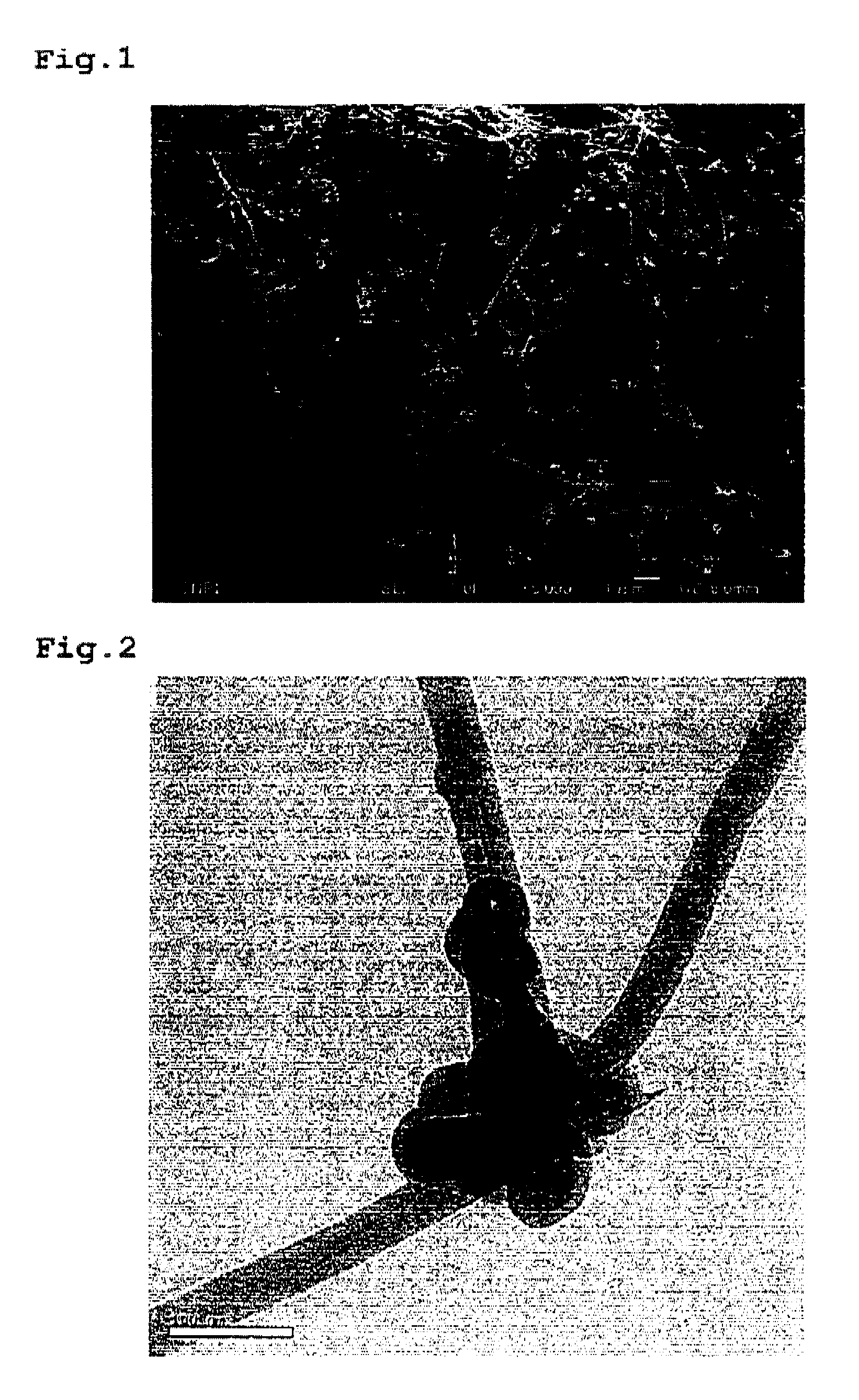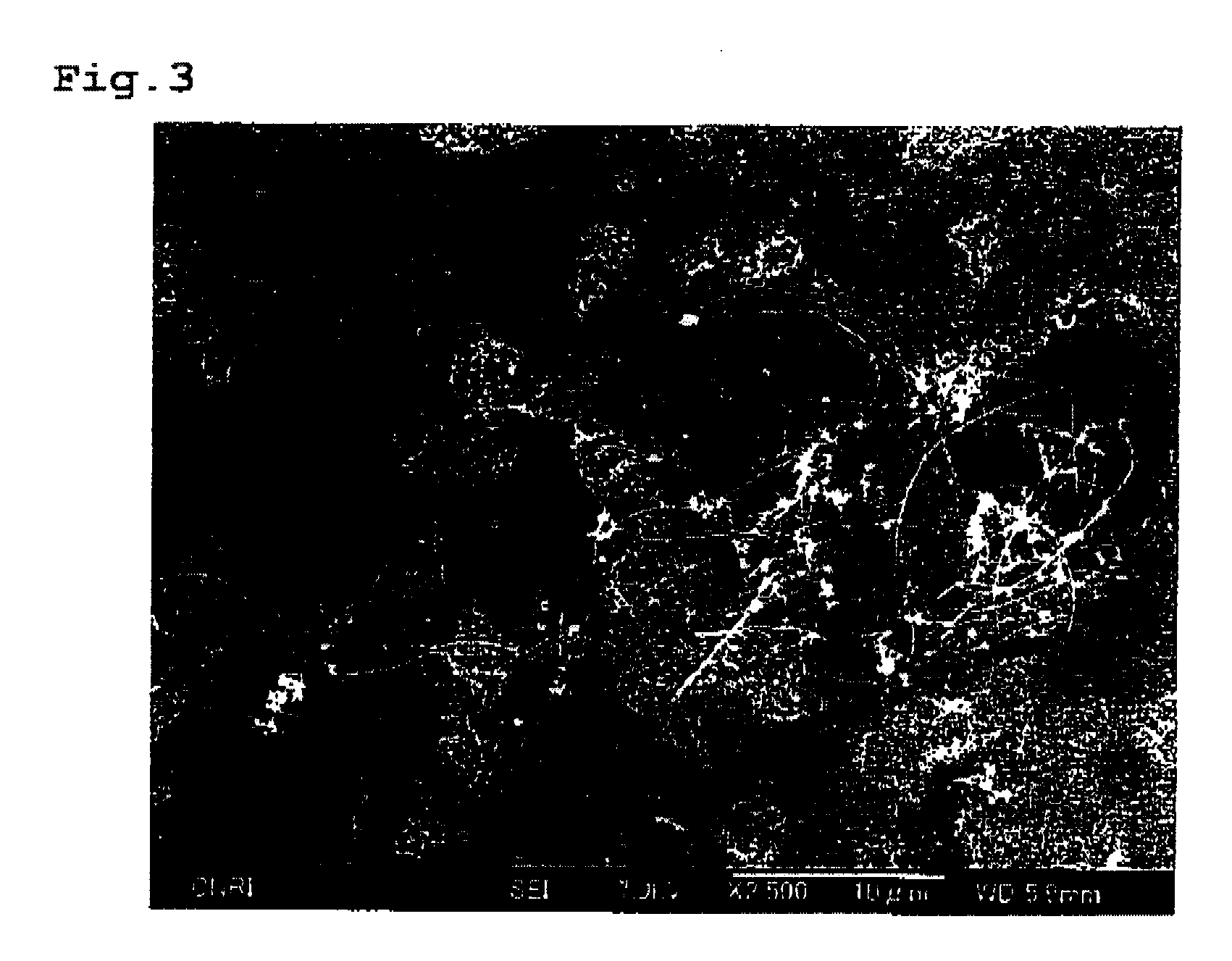Carbon Fibrous Conjunct and Composite Material Using Thereof
a technology of carbon fiber and conjunct, which is applied in the direction of metal/metal-oxide/metal-hydroxide catalyst, cell component, physical/chemical process catalyst, etc., can solve the problem of increasing and becoming a big problem, affecting the mechanical strength of the material obtained, and affecting the mechanical strength of the material. , to achieve the effect of good electrical conductivity, high density and high strength
- Summary
- Abstract
- Description
- Claims
- Application Information
AI Technical Summary
Benefits of technology
Problems solved by technology
Method used
Image
Examples
synthetic example 1
[0155]By the CVD process, carbon fibrous structures were synthesized from toluene as the raw material.
[0156]The synthesis was carried out in the presence of a mixture of ferrocene and thiophene as the catalyst, and under the reducing atmosphere of hydrogen gas. Toluene and the catalyst were heated to 380° C. along with the hydrogen gas, and then they were supplied to the generation furnace, and underwent thermal decomposition at 1250° C. in order to obtain the carbon fibrous structures (first intermediate).
[0157]The generation furnace used for the carbon fibrous structures (first intermediate) is illustrated schematically in FIG. 8. As shown in FIG. 8, the generation furnace 1 was equipped at the upper part thereof with a inlet nozzle 2 for introducing the raw material mixture gas comprising toluene, catalyst and hydrogen gas as aforementioned into the generation furnace 1. Further, at the outside of the inlet nozzle 2, a cylindrical-shaped collision member 3 was provided. The colli...
synthetic example 2
[0167]By the CVD process, carbon fibrous structures were synthesized using a part of the exhaust gas from the generation furnace as a recycling gas in order to use as the carbon source the carbon compounds such as methane, etc., included in the recycling gas, as well as a fresh toluene.
[0168]The synthesis was carried out in the presence of a mixture of ferrocene and thiophene as the catalyst, and under the reducing atmosphere of hydrogen gas. Toluene and the catalyst as a fresh raw material were heated to 380° C. along with the hydrogen gas in a preheat furnace, while a part of the exhaust gas taken out from the lower end of the generation furnace was used as a recycling gas. After it was adjusted to 380° C., it was mixed with the fresh raw material gas on the way of the supplying line for the fresh raw material to the generation furnace. The mixed gas was then supplied to the generation furnace.
[0169]The composition ratio in the recycling gas used were found to be CH4 7.5%, C6H6 0....
example 1
[0182]As raw materials, the fine carbon fibrous structures obtained from Synthetic Example 1, methanol, water, and methyl cellulose were mixed in a mixing ratio of carbon fibrous structures:methanol:water:methyl cellulose=20:20:9:1, and the resultant mixture was subjected to granulation by using a Vertical Granulator (manufactured by POWLEX Co., Ltd.) for 15 minutes. After the granulation, the prepared granules were dried at a temperature of not less than 100° C. in order to remove methanol and water. Thereby, granules of the carbon fibrous structures having a mean diameter of 500 μm were prepared.
PUM
| Property | Measurement | Unit |
|---|---|---|
| diameter | aaaaa | aaaaa |
| diameter | aaaaa | aaaaa |
| diameter | aaaaa | aaaaa |
Abstract
Description
Claims
Application Information
 Login to View More
Login to View More - R&D
- Intellectual Property
- Life Sciences
- Materials
- Tech Scout
- Unparalleled Data Quality
- Higher Quality Content
- 60% Fewer Hallucinations
Browse by: Latest US Patents, China's latest patents, Technical Efficacy Thesaurus, Application Domain, Technology Topic, Popular Technical Reports.
© 2025 PatSnap. All rights reserved.Legal|Privacy policy|Modern Slavery Act Transparency Statement|Sitemap|About US| Contact US: help@patsnap.com



